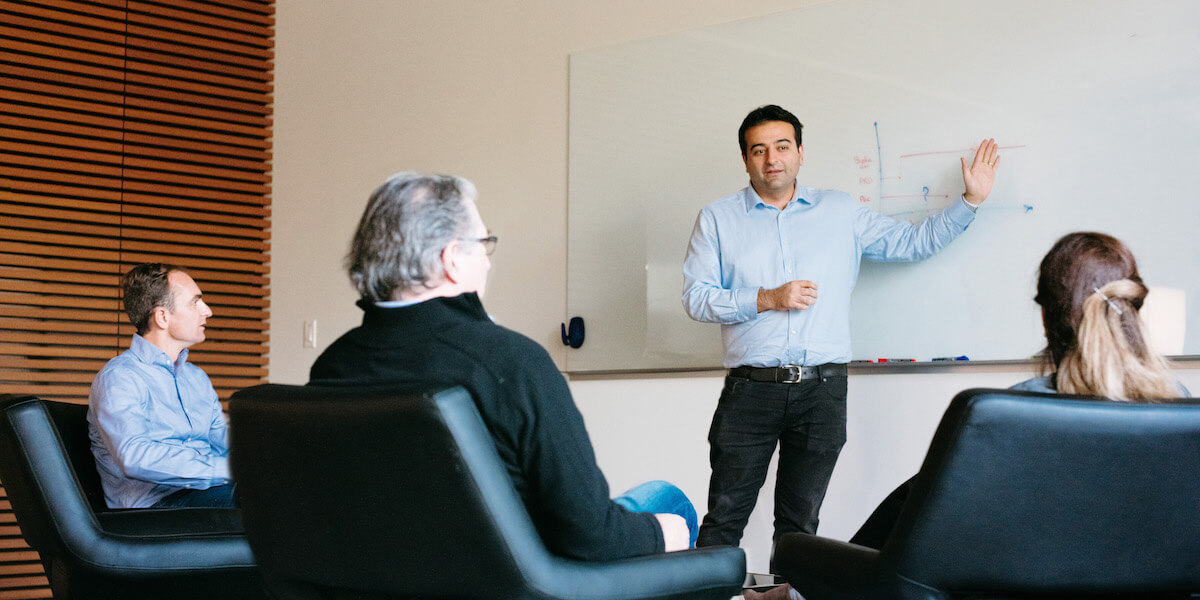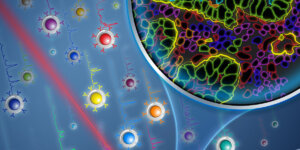
Co-founded by USC Viterbi alumnus Mahyar Salek, start-up Deepcell offers a novel platform with the potential for enormous impact in translational research, diagnostic testing, and therapeutics. (Image Courtesy of Salek)
The ability to isolate cells from a sample and study them forms the basis of research and insights for an array of clinical and translational applications. From developing novel pharmaceuticals to researching infectious diseases, life science professionals and clinical researchers rely on cell isolation techniques to answer important research questions and improve medical understandings.
Biotechnology start-up, Deepcell, hopes to transform this field of cell research with their novel AI-based technology.
The company’s technology offers a novel way to identify, sort, and isolate cells based on minute differences in their structures using machine learning. The technology has the unique ability to isolate extremely rare cells, occurring at frequencies as low as one in a billion, increasing the likelihood for potential discoveries and innovations in a wide range of fields, from genomics to oncology.
“The cell is the singular unit of biology, and understanding single-cell biology has tremendous potential applied to medicine, particularly where isolating rare cells in the circulation can help with diagnostics, for example in cancer, immunology, or prenatal testing,” said Deepcell co-founder Euan Ashley, a professor of medicine, genetics, and biomedical science at Stanford University.
Ashley co-founded the start-up in 2017 along with his then-postdoc student, Maddison Masaeli, now the company’s CEO, and USC Viterbi alumnus, Mahyar Salek, Ph.D. CS ’11, who serves as Deepcell’s chief technology officer.
“One thing about co-founding a company is that you have to go far beyond your job description,” Salek said. Salek initiated several technical projects, including developing the first generation of Deepcell’s deep neural nets and machine learning models, which are trained in various cell types to enable the classification of cells from their images, the first annotation tool and database, and some of the computer vision tools.
In his current role as CTO, Salek, a former Google product manager, oversees software, hardware, data science, product development, and a team of over 20 engineers and scientists.
Based in Menlo Park, California, Deepcell currently has over 40 employees. The company has raised a total of $25 million in funding over two rounds, with investments from companies including Andreessen Horowitz, Bow Capital, Fifty Years, DCVC, and Fenwick, and from angel investors such as Jeff Dean, the chief of Google Brain.
Pioneering Technology
Deepcell’s platform uses microfluidics-based technology to produce high-resolution imaging of single cells from a sample. These images are analyzed in real-time by artificial intelligence software trained through machine learning to precisely classify them based on miniscule visual differences.
To sort cells, this AI software references a database composed of currently over a billion of cell images. Deepcell has spent the last three years building this “cell morphology atlas,” which is continually improved by a process where new data is fed back into the AI architecture to hone its performance.
Unlike existing cell classification technologies, Deepcell’s platform can differentiate cells without relying on molecular surface markers or predetermined observable characteristics, like size or structure. Instead, the AI sorts cells based on infinitesimal visual differences, enabling samples of cells to be analyzed without defining a specific target ahead of time. This “hypothesis-free” approach allows more open-ended analysis, which Salek said can be transformative.
“Conventional alternatives to Deepcell’s technology require pre-defining specific biomarkers, which limits the ability for researchers to see the big picture of the very diverse and complex biological phenomena that is the cell,” Salek said.
Another noteworthy feature of Deepcell’s technology is that it sorts cells without altering or destroying them. By maintaining the viability of these cells, they can later be cultured and grown for further analysis.
“Our technology provides a very attractive alternative to traditional methods, like antibody staining, that change the properties of the cell,” Salek said. “Our process preserves the cell and maintains its complex transcriptomic profile, enabling researchers to examine the DNA, RNA, and proteins of an intact, unperturbed cell.”
Novel Applications
The potential uses for Deepcell’s platform are boundless, but one particularly inspiring application is in the field of oncology, Salek said.
To understand cancer and develop therapeutics for it, it is key to characterize the microenvironment in which the tumor grows. When a malignant tumor develops in the body, some of these cancer cells get into the bloodstream, but they are difficult to isolate there because of their scarcity. Deepcell’s technology would give doctors and researchers access to these cells, both within the tumor and in circulation, enabling an unprecedented understanding of cancer biology, and in the future early detection and monitoring of cancer.
According to Salek, there are multiple applications for the technology in the field of oncology, but also in other areas, such as prenatal testing.
During pregnancy, some cells from the fetus end up circulating in the mother’s bloodstream. However, these cells are very rare compared to the mother’s cells, making them extremely difficult to isolate. In a sample containing one million maternal cells, there might be one fetal cell. Deepcell’s platform is the only existing technology with the ability to accurately isolate these fetal cells.
“The application of our technology for noninvasive prenatal testing is very, very powerful,” Salek said. “It gives medical professionals a way to check on the health of the developing fetus without ever touching the fetus, which can be associated with possible complications and risks. I believe this application of our technology could eventually entirely replace invasive prenatal testing practices.”
Other applications for Deepcell’s platform include areas like immunotyping, tissue profiling, cell therapy manufacturing, and drug discovery, Salek added.
Future Plans
Deepcell is now beginning to take steps towards commercialization, with the vision of offering the platform as a tool that would allow collaborators to develop their own applications.
“The scope of potential applications for this technology is far too large to be developed by a single company,” Salek said. “Our hope is to build a platform that enables us to collaborate with researchers and medical professionals as they develop their own applications.”
In June, Deepcell announced a collaboration with Jianyu Rao, a professor of pathology and epidemiology at the University of California, Los Angeles. The collaboration will focus on using Deepcell’s platform to identify and sort cancer cells from clinical cytology samples to advance cancer research. Deepcell hopes to continue to partner with scientific researchers and medical experts in the future.
“My vision for the future of Deepcell is that our technology will prove indispensable to researchers and clinicians in a wide range of areas,” Salek said. “My hope is that our platform will facilitate novel insights in the field of biology that will contribute to better therapeutics, better diagnostics, and better healthcare.”
Published on September 9th, 2021
Last updated on September 9th, 2021









